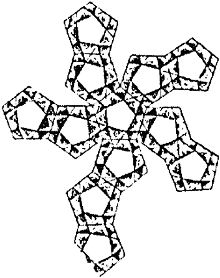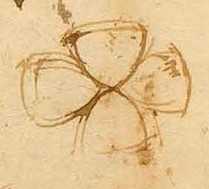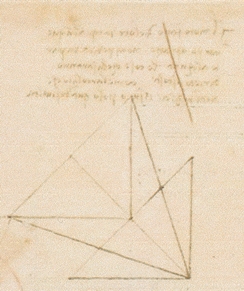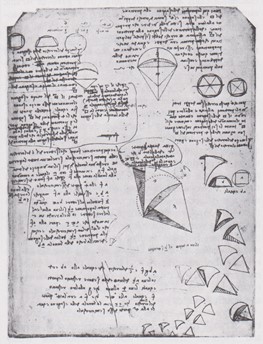| The Public Paperfolding History Project
x |
|||||||
| Was Leonardo da Vinci a Paperfolder? | |||||||
| The
question of whether, and to what extent Leonardo da Vinci
(1452-1519) folded paper for anything other than purely
practical everyday purposes is difficult to resolve.
Although some of the statements in the literature about
Leonardo da Vinci being a paperfolder are clearly myths,
others are more difficult to dismiss without considerably
more scholarship than I possess. I am not aware of any
definitive published study that would assist here. This page therefore mainly attempts to simply collect together evidence on this subject rather than to attempt to reach definitive conclusions . Please contact me if you know any of this information is incorrect or if you have any other information that should be added. Thank you. ********** Leonardo and Luca Pacioli Leonardo da Vinci had a close friendship / working relationship with Luca Pacioli (1447 -1517) whose book 'De Viribus Quantitatis' contains descriptions of several paperfolds. According to the New World Encyclopaedia (https://www.newworldencyclopedia.org/entry/Luca_Pacioli) 'Pacioli collaborated with, lived with, and taught mathematics to Leonardo da Vinci. ... In 1497, Pacioli completed another work on geometric figures, the Divina Proportione, for which da Vinci contributed the illustrations ... In December 1499, Pacioli and Leonardo were forced to flee Milan when Louis XII of France seized the city and drove their patron out. After that, Pacioli and Leonardo frequently traveled together, first to Mantua, then to Venice and, by the spring of 1500, to Florence, each seeking patrons and commissions. As far as I know, however, there is no evidence to link Leonardo to any of the paperfolds published by Pacioli or even to show that he was aware of them. ********** Polyhedral nets On page 50 of his book 'A History of Folding in Mathematics', published by Springer in 2018, Michael Friedman notes that in Max Steck's 'Dürers Gestaltlehre der Mathematik und der bildenden Künste (Dürer's Gestalt Theory of Mathematics and the Fine Arts), published by Halle an der Saale in 1948, there is a reproduction of a drawing by Leonardo da Vinci showing the foldable net of a dodecahedron which appears in 'a (possible) later edition of Pacioli's Divina Proportione'.There does not seem to be any reason for such a drawing other than to allow the construction, by folding, of a three dimensional model and it is therefore reasonable to take this as evidence of paperfolding. However, Friedman does not give a reference for the original work, which I take to mean that he could not verify Steck's information from the original document.
Friedman also states that Folio 198 recto of the Codex Atlanticus shows a projection of the dodecahedron. There is a full copy of this work online at www.codex-atlanticus.it/#/Overview. I cannot, however, reconcile the page numbers of the online copy with the reference Friedman gives and cannot find the drawing he refers to. ********** Octant projections On the same page of his book Michael Friedman further states that Folio 178 verso of the Codex Atlanticus shows 'the unfolding of the sphere, or, more precisely, a sketch of Globus gores'. According to Christopher W. Tyler in his article 'Leonardo da Vinci's World Map' in 'Cosmos and History: The Journal of Natural and Social Philosophy, vol. 13, no. 2, 2017' available online at http://openaccess.city.ac.uk/id/eprint/17683/1/Tyler_DaVinciWorldMap_C%26H2015.pdf this page, which can be dated to 1508, shows sketches of various map projections, some of which, including the Octant Projection (see detail), are found here for the first time and are therefore presumed to be original to Leonardo.
It should be noted, however, that because octant projections, and other kinds of globus gores, printed on paper, can, in theory, and ignoring the need for some judicious stretching, be folded onto the surface of a sphere, this does not mean that Leonardo conceived them in this way. He may well have just conceived octant projections as a way of mapping the curved surface of the earth onto the flat surface of a map, a conception that does not involve folding in any way. ********** Leonardo and the Flapping Bird In modern times the commonly repeated statement that Leonardo was a paperfolder seems to have initially derived from a passage in the Preface to the 1937 book 'Paper Toy Making', by Margaret Campbell. This Preface was written by her son Roy Campbell and is dated 1936. The passage reads 'This hobby is full of homely wisdom. But it has among its fanciers several outstanding intellects: for example Leonardo, Shelley and Unamuno. I can quite imagine that the traditional flying bird might have been one of the lighter butterfly-fancies of Leonardo's brain ...' The idea that Leonardo might have invented the Flapping Bird is a piece of whimsy for which there is not the slightest piece of evidence. However, this sentence seems to have created an enduring myth. ********** Geometric exercises and the paper plane 1958 On 27th June 1958 an article by staff journalist Meyer Berger was printed in the New York Times under the title 'Origami, the Ancient Art of Paper-Folding, Has Gramercy Square Disciple' which was about Lillian Oppenheimer and her interest in paperfolding. It contains the words 'Her literature tells her that great men have been, or are, folders - Leonardo da Vinci, Shelley, the magician Houdini, Professor Unamuno...' 'Her literature', in this context, is quite possibly the words by Roy Campbell quoted above. ********** 1959 In 1959 Edward Kallop organised an exhibition about paperfolding, titled 'Plane Geometry and Fancy Figures', at the Cooper Union Museum of the Arts and Decoration, where he worked. In the Introduction to the exhibition catalogue he wrote:
This information is amplified in the notes:
In order to verify Kallop's interpretation it would be necessary, first, to identify the pages in the Codex Atlanticus that he refers to and then to study the drawings and their associated text. Unfortunately I cannot reconcile Kallop's references with the page numbers in the online version of the Codex Atlanticus (see above) and so cannot identify the pages / drawings he refers to. None of the drawings in the Codex Atlanticus seem, on their own, to evidence that Leonardo da Vinci used paper folding as a mathematical exercise. It is possible that the acompanying text, which I unfortunately am not a sufficiently able scholar to read, may put a different perspective on the matter. It is however, perhaps, significant that Michael Friedman's 'A History of Folding in Mathematics', published by Springer in 2018, which traces the development of mathematical paperfolding throughout this period, does not mention anything about the existence of geometrical paperfolding exercises in the Codex Atlanticus. (As an aside, it is worth noting that in his article 'Old European Origami' (https://britishorigami.info/lister/oldeuro.php) David Lister wrote 'I have never been able to inspect the Codex Atlanticus or a facsimile copy, but Roberto Morassi has done so and in Roberto's opinion, none of Kallop's references relates to paper folding.' This information is incorrect. Roberto Morassi has confirmed to me that he has never in fact examined the Codex Atlanticus, or a facsimile of it.) Kallop states that one of the drawings closely resembles a folded paper plane. The only drawing I can find in the Codex Atlanticus that resembles a paper plane is on page 874 Recto. I cannot read the accompanying text and so cannot tell whether or not this is intended to be a foldable figure.
Whatever the intention, and whether by chance or design, this figure is indeed foldable, provided you begin with a rectangle with edges in the proportion of approximately 1:1.69. The result does superficially resembles a paper plane, viewed from above, but it has no keel, and therefore would not fly. Oddly, however, if you do give the design a basic keel, formed by adding three parallel folds, the resulting paper plane will fly quite satisfactorily. ********** 1966 The initial advert for The 1st International Paper Aircraft Competition, held in 1967, which appeared in'The New York Times' on 12th December 1966, refers to Leonardo da Vinci as 'the Patron Saint of paper airplanes'. and advises that winners will receive a 'Leonardo' trophy. ********** 1989 Peter Engel's book 'Folding the Universe', published by Vintage Books in 1989, states 'Leonardo da Vinci entered into his Codex Atlanticus a number of geometric exercises in paperfolding along with a study of the velocity and motion of paper airplanes'. The idea that the Codex Atlanticus includes a study of the motion and velocity of paper planes, and not just a drawing of one, seems to be new. I am not aware of the evidence on which Engel based this assertion. His book provides an illustration showing this page from the Codex Atlanticus. I cannot read the text and so remain unclear as to what this page is intended to show.
********** |






